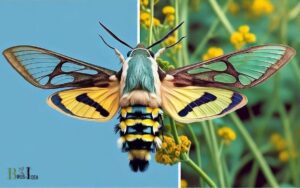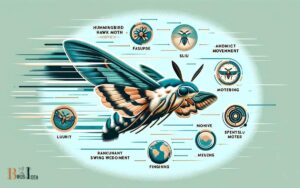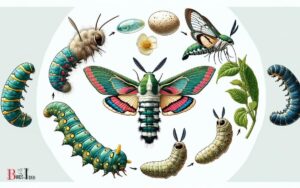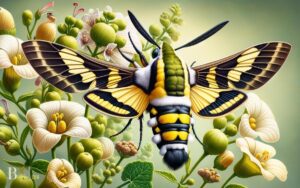Life Cycle of a Hummingbird Moth: Discover!
The life cycle of the hummingbird moth encompasses four stages: egg, larva (caterpillar), pupa (chrysalis), and adult.
This process, known as complete metamorphosis, begins when a female hummingbird moth lays her eggs on a suitable host plant.
After hatching, the caterpillars feed voraciously on the plant leaves, growing rapidly before entering the pupal stage.
Within the pupa, the caterpillar undergoes a transformation, emerging as a fully developed adult moth ready to feed on nectar and pollinate plants.
The life cycle of the hummingbird moth is a striking example of metamorphosis, which includes:
Each stage is crucial for the survival of the species and contributes to the biodiversity of the ecosystem.
Discover the enthralling stages of the hummingbird moth’s life, from a minute egg to a vibrant adult pollinator.
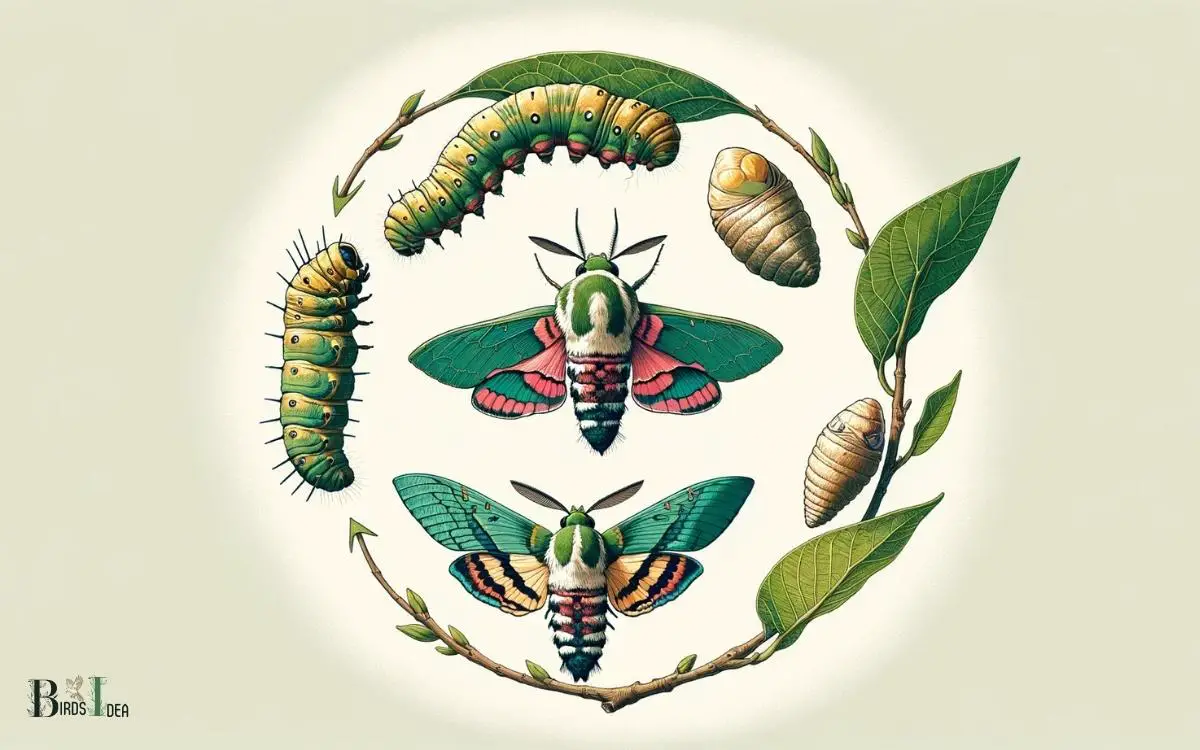
Key Takeaway
Stages of the Hummingbird Moth Life Cycle – A Detailed Overview
| Life Cycle Stage | Description | Duration | Function |
|---|---|---|---|
| Egg | Laid on host plants; beginning of life. | 3-10 days | Hatching into caterpillars. |
| Larva | Caterpillar stage; feeding on leaves. | 2-4 weeks | Growth and pupa preparation. |
| Pupa | Chrysalis stage; transformation occurs. | 2-3 weeks | Metamorphosis into adult. |
| Adult | Final stage; capable of flight and mating | 2-5 weeks | Pollination and reproduction |
Egg Stage
When and where does the hummingbird moth lay its eggs?
The hummingbird moth, scientifically known as Hemaris thysbe, lays its tiny, oval, greenish eggs on the underside of leaves, typically on the host plants like honeysuckle, hawthorn, or snowberry.
After a gestation period of around 8 to 10 days, the eggs hatch into larvae. These eggs are strategically placed to provide safety and nourishment for the emerging larvae. The female moth selects the location carefully to ensure the survival of her offspring.
These eggs are usually laid in clusters, and each egg is about the size of a pinhead. Once the eggs hatch, the larva stage begins, marking the next phase in the life cycle of the hummingbird moth.
Larva Stage
After the eggs hatch, the larvae emerge and begin their journey through the larva stage of the hummingbird moth’s life cycle. During this stage, the larvae undergo several transformations as they grow and develop.
- The larvae feed voraciously on the leaves of their host plants, consuming large amounts of vegetation to fuel their rapid growth.
- As they grow, the larvae molt several times, shedding their exoskeleton to accommodate their increasing size.
- The larvae develop into distinct instars, each stage marked by specific physical characteristics and behaviors.
- Finally, after several weeks of feeding and growing, the larvae enter the pupa stage, where they’ll undergo metamorphosis and emerge as adult hummingbird moths.
Pupa Stage
During the pupa stage, the transformation process from larva to adult moth occurs. This stage typically lasts for about 10-14 days, during which the pupa is in a dormant state.
The pupa also exhibits survival adaptations to protect itself from predators and environmental conditions.
Pupa Transformation Process
The pupa transformation process of a hummingbird moth occurs within a protective cocoon. This stage is crucial for the metamorphosis from a caterpillar to an adult moth.
During this process, several remarkable changes take place:
- Internal reorganization: Inside the pupa, the caterpillar’s body undergoes a complete reorganization as it prepares to transform into an adult moth.
- Tissue breakdown and reformation: The caterpillar’s tissues break down into a kind of cellular soup, from which the adult moth’s structures form.
- Development of wings: The rudimentary wings of the moth develop within the pupa, growing and taking shape for the moth’s eventual flight.
- Coloration and patterning: The distinct coloration and patterning of the adult moth’s wings and body start to become visible during this transformative stage.
The pupa transformation process is a marvel of nature, leading to the emergence of a beautiful and agile hummingbird moth.
Duration of Pupa Stage
The pupa stage of a hummingbird moth’s life cycle typically lasts for around 10 to 15 days, during which remarkable transformations occur within the protective cocoon.
During this time, the pupa undergoes a process called metamorphosis, where the caterpillar’s body reorganizes itself into the adult moth.
Within the pupa, the caterpillar’s tissues break down and reform into the structures of the moth, including the wings, legs, and proboscis.
This stage is crucial for the development of the moth’s adult characteristics. As the pupa stage nears its end, the moth’s body becomes visible through the translucent pupal skin.
Once the transformation is complete, the adult hummingbird moth emerges from the pupa, ready to begin its brief but impactful life as a pollinator.
Pupa Survival Adaptations
Adapting to their environment, pupae of the hummingbird moth develop survival mechanisms crucial for their transition into the adult stage.
During this stage, the pupa exhibits remarkable adaptations, ensuring its survival in various conditions:
- Camouflage: The pupa’s outer casing often resembles the surrounding environment, effectively blending in and avoiding detection by predators.
- Protective Casing: The pupa’s outer shell is hard and durable, providing protection from predators and environmental hazards.
- Reduced Metabolic Rate: By entering a state of dormancy, the pupa conserves energy and can withstand periods of scarcity or harsh conditions.
- Chemical Defense: Some pupae possess chemical deterrents, deterring predators from attacking them.
These adaptations equip the pupa with the tools necessary to endure the vulnerable pupal stage and emerge successfully as an adult hummingbird moth.
Metamorphosis
During metamorphosis, the pupal stage transformation occurs, leading to a complete restructuring of the insect’s body.
This process involves the breakdown of old tissues and the formation of new ones, enabling the insect to undergo a remarkable physical transformation.
The metamorphosis stage is a crucial period in the life cycle of a hummingbird moth, marking the transition from a pupa to an adult capable of flight and reproduction.
Pupal Stage Transformation
The pupal stage of a hummingbird moth marks a remarkable transformation from caterpillar to adult moth.
During this stage, the caterpillar forms a protective casing around itself, known as a pupa, where it undergoes a complete metamorphosis.
Inside the pupa, several extraordinary changes take place:
- The caterpillar’s body dissolves into a soupy substance, reorganizing into the body of a moth.
- Imaginal discs, which contain the genetic information for the moth’s adult features, develop into wings, legs, and other body parts.
- The respiratory system shifts from one suited for life on land to one designed for life in the air.
- The digestive system transforms to accommodate the adult moth’s liquid diet.
This process typically takes a couple of weeks, ultimately culminating in the emergence of a fully developed hummingbird moth.
Insect Body Restructuring
After the pupal stage, the caterpillar undergoes a remarkable process of body restructuring known as metamorphosis, transforming into the adult hummingbird moth. During this stage, the caterpillar’s body undergoes significant changes.
First, it secretes enzymes that dissolve its old body, essentially turning itself into a nutritive soup.
From this soup, specific groups of cells, called imaginal discs, begin to differentiate and form the various body parts of the adult moth. The wings, legs, antennae, and other structures develop rapidly.
As this restructuring occurs, the moth’s body takes on the characteristic features of its species.
This transformation is a critical and awe-inspiring phase in the life cycle of the hummingbird moth, leading to its emergence as a fully developed adult insect.
This restructuring process sets the stage for the subsequent section about the adult stage, where the moth’s mature form and behavior will be explored.
Adult Stage
At the adult stage, a hummingbird moth actively seeks nectar from various flowers to sustain its energy. This stage is crucial for the moth’s survival and reproduction.
During this phase, the moth exhibits remarkable behaviors and characteristics:
- Fluttering wings: The moth hovers over flowers using rapid wing movements, resembling a hummingbird.
- Long proboscis: It extends its long, straw-like proboscis to reach the nectar deep within the flowers.
- Nocturnal activity: The moth is most active during dusk and dawn, utilizing its exceptional vision to navigate in low light conditions.
- Pollination: As it feeds, the moth inadvertently transfers pollen from one flower to another, aiding in the pollination process.
This stage marks the peak of the hummingbird moth’s life cycle, where it plays a vital role in its ecosystem.
Ecological Importance
During this stage, they significantly contribute to the ecosystem by aiding in the pollination of various flowers.
Hummingbird moths play a crucial role as pollinators, helping to fertilize a wide variety of plants while seeking nectar.
Their long proboscis allows them to reach deep into flowers, transferring pollen from one bloom to another as they feed. This process supports the reproduction and genetic diversity of flowering plants.
In turn, this benefits other wildlife that rely on these plants for food and shelter. By acting as pollinators, hummingbird moths help maintain the delicate balance of their ecosystems.
Their ecological importance extends beyond their own needs, making them valuable contributors to the health and sustainability of the environments in which they thrive.
How Long do Hummingbird Moths Live?
The lifespan of hummingbird moths, also known as sphinx moths or hawk moths, varies depending on the species.
In general, the adult lifespan is relatively short, typically ranging from a few weeks to a couple of months. During this time, their primary focus is on mating and laying eggs.
The larval stage, which occurs before metamorphosis into the adult moth, may last a few weeks to a couple of months, depending on environmental conditions and the specific species.
It’s important to note that the lifespan of hummingbird moths can be influenced by factors such as climate, habitat, and availability of food sources.
What is the life cycle of a Black and White Hummingbird Moth?
The life cycle of the discover black and white hummingbird moth consists of four stages: egg, larva, pupa, and adult. After hatching, the larva feeds on nectar and grows quickly before entering the pupa stage. The adult moth emerges and begins the cycle again by laying eggs.
Life Span of Hummingbird Moth
The lifespan of a hummingbird moth varies based on factors such as species, environmental conditions, and local climate.
In general, the adult stage of a hummingbird moth’s life lasts a few weeks to a couple of months.
During this time, their main activities include mating and laying eggs. The larval stage, which occurs before the moth transforms into an adult, may last several weeks.
For more precise information, it’s helpful to identify the specific species of hummingbird moth you’re referring to, as different species within the family Sphingidae may have slightly different lifespans.
Conclusion
Despite its appearance as a tiny hummingbird, the hummingbird moth undergoes a remarkable life cycle from egg to adult. It plays a crucial role in pollination, making it an important member of the ecosystem.
Ironically, this small moth has a big impact on the environment, proving that even the tiniest creatures can have a significant influence on the world around them.

